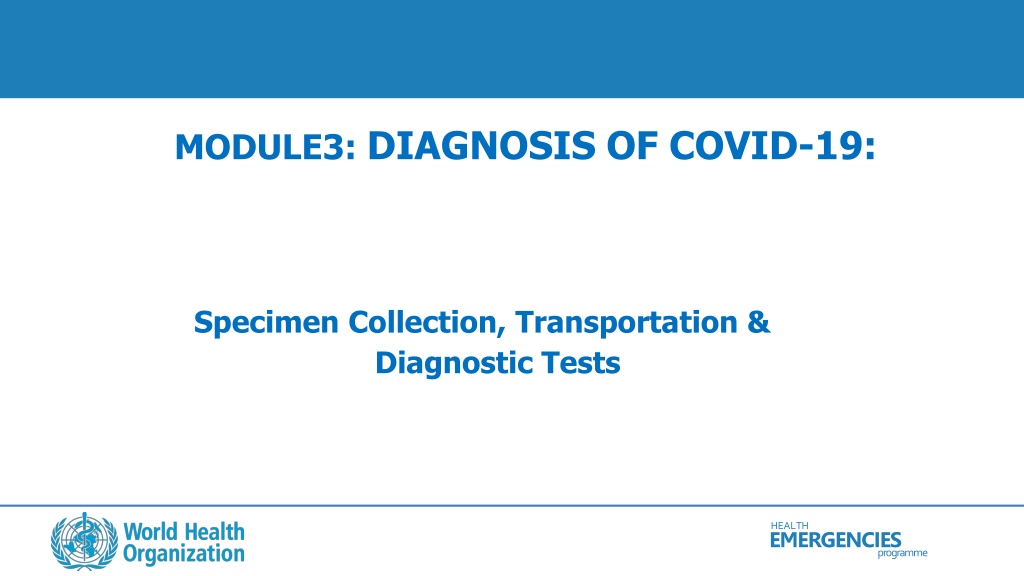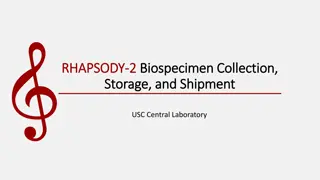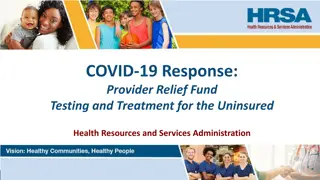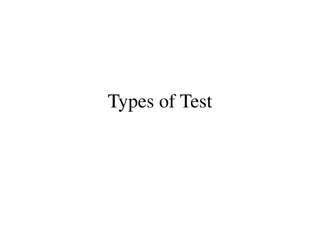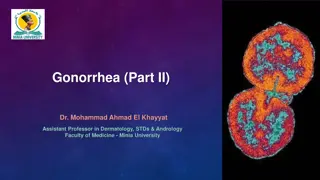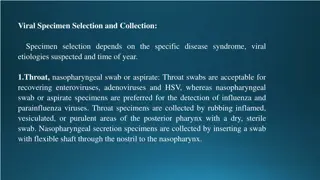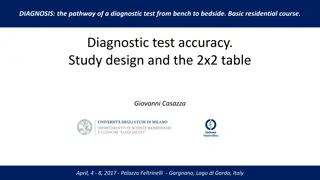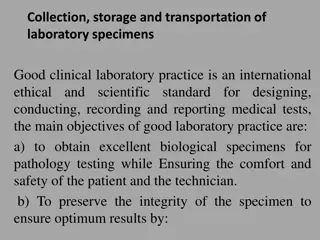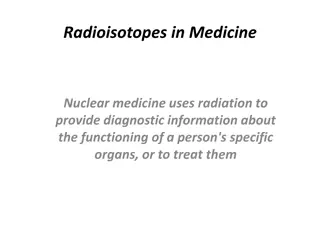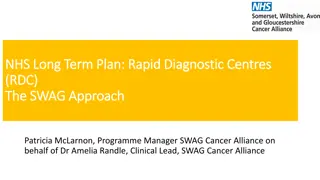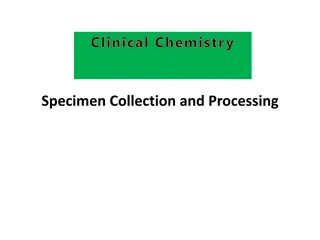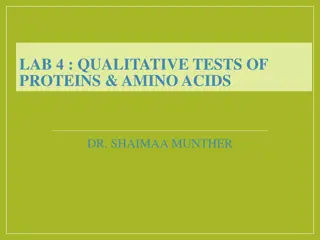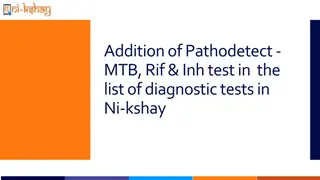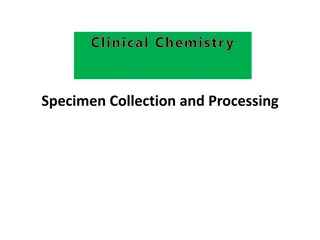COVID-19 Specimen Collection & Diagnostic Tests
Rapid and accurate specimen collection is crucial for diagnosing COVID-19. Learn about optimal transportation conditions, different diagnostic tests, and specimen collection guidelines to combat health emergencies effectively.
Download Presentation

Please find below an Image/Link to download the presentation.
The content on the website is provided AS IS for your information and personal use only. It may not be sold, licensed, or shared on other websites without obtaining consent from the author.If you encounter any issues during the download, it is possible that the publisher has removed the file from their server.
You are allowed to download the files provided on this website for personal or commercial use, subject to the condition that they are used lawfully. All files are the property of their respective owners.
The content on the website is provided AS IS for your information and personal use only. It may not be sold, licensed, or shared on other websites without obtaining consent from the author.
E N D
Presentation Transcript
MODULE3: DIAGNOSIS OF COVID-19: Specimen Collection, Transportation & Diagnostic Tests HEALTH EMERGENCIES programme
Learning objectives At the end of this session, you will be able to: Describe when and what specimens to collect for Laboratory diagnosis of COVID-19. To describe the Optimal conditions for transportation of samples for COVID-19. To describe the characteristics of diffrenet diagnostic tests used for the diagnosis of COVID-19. HEALTH EMERGENCIES programme
Rapid collection and testing of appropriate specimens from suspected cases is a priority and should be guided by a laboratory expert. As extensive testing is still needed to confirm the COVID-19 virus and the role of mixed infection has not been verified, multiple tests may need to be performed and sampling sufficient clinical material is recommended. Local guidelines established by the testing Lab (UVRI) should be followed regarding patient or guardian s informed consent for specimen collection, testing and potentially future research.
Ensure that SOPs are available, and the appropriate staff is trained and available for appropriate collection, specimen storage, packaging and transport. There is still limited information on the risk posed by the reported coronavirus found in Wuhan, but it would appear samples prepared for molecular testing could be handled as would samples for influenza of with maximum biosafety precautions as appropriate. Attempts to culture the virus may require heightened biosafety control measures.
Specimen collection HEALTH EMERGENCIES programme
Collect correct biological Specimens Respiratory material* (nasopharyngeal and oropharyngeal swab in ambulatory patients sputum (if produced) and/or endotracheal aspirate or bronchoalveolar lavage in patients with more severe respiratory disease) Serum for serological testing, acute sample and convalescent sample (this is additional to respiratory materials and can support the identification of the true agent, once serologic assay is available)
Upper respiratory tract samples Use appropriate PPE during collection procedure (gown, mask, gloves and eye protection). Nasal or nasopharyngeal samples have highest yield for detection of the virus. Also collect throat swabs to improve suspected emerging COVID-19. the yield for Collect samples as soon as possible. Ideally samples should be collected less than 4 days from illness onset for seasonal influenza A or B, as yield goes down as viral shedding decreases.. This may also be true for COVID-19 HEALTH EMERGENCIES programme
Risk assessment for appropriate use of PPE Minimize direct unprotected exposure to blood and body fluids. SCENARIO GLOVES GOWN HAND HYGIENE MEDICAL MASK EYE- WEAR Always before and after patient contact, and after contaminated environment If direct contact with blood and body fluids, secretions, excretions, mucous membranes, non-intact skin If there is risk of splashes onto the health care worker s body If there is a risk of splashes onto the body and face x x x x x x x x x x x HEALTH programme EMERGENC IES
Use sterile dacron or rayon swabs. Do not use cotton swabs or wood shafts as can interfere with RT-PCR assays Nasopharyngeal swabs Throat swabs HEALTH EMERGENCIES programme
Lower respiratory tract samples Also collect lower respiratory tract samples in patients with radiographic evidence or clinical diagnosis of lower respiratory tract disease, in certain situations, if results will impact clinical interventions: expectorated sputum tracheal aspirates bronchoalveolar lavage. Can generate aerosols, thus use airborne precautions during procedure. HEALTH EMERGENCIES programme
In intubated patient, can collect tracheal aspirate Collection can generate aerosols, thus use airborne precautions. Using sterile collection trap. Do not send suction catheter tip to laboratory. HEALTH EMERGENCIES programme
Benefits of lower respiratory tract samples Higher sensitivity than upper respiratory specimens for zoonotic influenza virus, MERS-CoV and Probably for COVID-19. Increases diagnostic yield for seasonal in if upper samples are negative or tested late and may be the same for COVID-19. Can also be used to tested for other pathogens such bacterial, fungal and parasitic infections if suspected as co-infection. e.g. M. tuberculosis, PjP. HEALTH EMERGENCIES programme
Sample Transportation There must be ready means of transport to take the sample to lab immediately upon collection. All specimens collected for laboratory investigations should be regarded as potentially infectious, and HCWs who collect, or transport clinical specimens should adhere rigorously to infection prevention and control guidelines and national or international regulations for the transport of dangerous goods (infectious substances) to minimize the possibility of exposure to pathogens. Implement the appropriate infection prevention and control precautions during transportation. *Good communication with the laboratory and provide needed information* To ensure proper and fast processing of samples and to assure adequate biosafety measures in the laboratory, communication and information sharing is essential. Be sure you have alerted the laboratory of the urgency and situation before sending the sample. Also assure that specimens are correctly labelled, and diagnostic request forms are filled out properly and clinical information is provided (see box: information to be recorded)
Specimen type Collection materials Dacron or polyester flocked swabs* Transport to Laboratory 4 C Storage till testing Comment Nasopharyngeal and oropharyngeal swab 5 days: 4 C >5 days: -70 C The nasopharyngeal andoropharyngeal swabs should be placed in the same tube toincrease the viral load. There may be some dilutionof pathogen, but still a worthwhile specimen Broncoalveolar Lavage sterile container 4 C 48 hours: 4 C >48 hours: -70 C (Endo)tracheal aspirate, nasopharyngeal aspirate or nasal wash Sputum Sterile Container 4 oC 48 hours: 4 C >48 hours: -70 C Sterile container 4 C 48 hours: 4 C >48 hours: -70 C 24 hours: 4 C >24 hours: 70 C Ensure the material is from the lower respiratory tract Tissue from biopsy or autopsy including from lung Serum (2 samples acute and convalscent possibly 2-4 weeks after acute phase. Whole blood sterile container with saline Serum separator tubes (adults: collect 3-5mls whole blood) 4 C collection tube 4 C Collect paired samples: Acute-first week of illness; Convalscent-2-3weeks later For antigen detection particularly in the first week of illness 5 days: 4 C >5days:- 70 C 5 days: 4 C >5days:- 70 C 5 days: 4 C >5days:- 70 C 4 C Urine Collectin container Urine 4 C
Information to be recorded for the sample Patient information name, date of birth, sex and residential address, unique identification number, other useful information (e.g. patient hospital number, surveillance identification number, name of hospital, hospital address, room number, physicians name and contact information, name and address for report recipient), Date and time of sample collection, Anatomical site and location of specimen collection, Tests requested, Clinical symptoms and relevant patient history (including vaccination and antimicrobial therapies received, epidemiological information, risk factors).
Laboratory testing HEALTH EMERGENCIES programme
Diagnostic tests for C0VID-19 This is a rapidly evolving area of work. Real time (RT-PCR) is currently recommended for diagnosis of patients with suspected COVID-19. As sequence information from the COVID-19 has recently been made available, PCR assays can be designed to detect these sequences. For latest information refer to your national laboratory and health ministry recommendations and to the COVID-19 website. https://www.who.int/emergencies/diseases/novel-coronavirus-2019 https://www.who.int/emergencies/diseases/novel-coronavirus-2019/technical- guidance HEALTH EMERGENCIES programme
Diagnostic tests for 2019-nCoV Laboratories may desire to use a pan-coronavirus assay for amplification followed by sequencing of amplicons from non-conserved regions for characterization and confirmation. The importance of the need for confirmation of results of testing with pan- coronavirus primers is underscored by the fact that four human coronaviruses (HcoVs) are endemic globally: HCoV-229E, HCoV-NL63, HCoV-HKU1 as well as HCoV-OC43. The latter two are. betacoronaviruses. Two other betacoronaviruses that cause zoonotic infection in humans are MERS-CoV, acquired by. contact with dromedary camels and SARS arising from civets and cave-dwelling horseshoe bats HEALTH EMERGENCIES programme
Diagnostic tests for 2019-nCoV Alternatively, amplification and detection of 2019-nCoV specific sequences can be diagnostic without the necessity for further sequencing. If testing does not occur in an expert/reference laboratory it is encouraged to send the sample for confirmation to a regional, national or international. reference laboratory with pan-coronavirus or specific 2019-nCoV detection capacity. WHO can assist Member States to identify laboratories able to provide this support If case management requires, screen also for other common causes of respiratory illness according to local guidelines, as co-infections can occur. HEALTH EMERGENCIES programme
Laboratory Crterion for Cure In hospitalized patients with confirmed nCoV infection, repeat URT and LRT samples should be collected to demonstrate viral clearance. The frequency of specimen collection will depend on local circumstances but should be at least every 2 to 4 days until there are two consecutive negative results (both URT and LRT samples if both are collected) in a clinically recovered patient at least 24 hours apart. If local infection control practice requires two negative results before removal of droplet precautions, specimens may be collected as often as daily.
Summary Sample for diagnosis of COVID should be collected as soon as possible and delivered to laboratory to get a good diagnostic yield. It is important to apply appropriate IPC precautions during the sample collection. It important to use to the correct sample collection container and to use a viral transport medium and at the right tempearure during the sample transportation to get a good diagnostic yield. Lower tract samples can be useful when upper samples are not diagnostic and usually provided a better diagnostic yield. HEALTH EMERGENCIES programme
Acknowledgements Contributors Dr Cheryl Cohen, National Institute for Communicable Diseases (NICD), Johannesburg, South Africa Dr Shabir Madhi, University of the Witwatersrand, Johannesburg, South Africa Dr Niranjan Bhat, Johns Hopkins University, Baltimore, USA Dr Tim Uyeki, Centers for Disease Control and Prevention, Atlanta, USA Dr Fred Hayden, University of Virginia, USA Dr Owen Tsang, Hospital Authority, Princess Margaret Hospital, Hong Kong, SAR, China Dr Leo Yee Sin, Tan Tock Seng Hospital, Communicable Disease Centre, Singapore Dr Janet Diaz, WHO Consultant, San Francisco CA, USA Dr Vu Quoc Dat, Hanoi Medical University and National Hospital of Tropical Diseases, Hanoi, Viet Nam Dr Natalia Pshenichnaya, Rostov State Medical University, Russian Federation HEALTH EMERGENCIES programme
